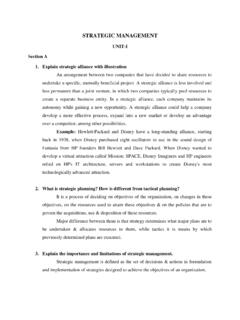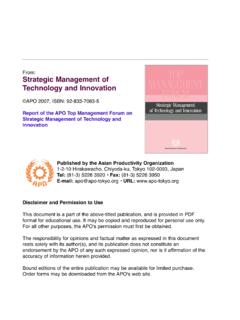Transcription of STRATEGIC ENTREPRENEURSHIP JOURNAL
1 The STRATEGIC management Society, in conjunction with John Wiley & Sons, is pleased to announce the launch of a new quarterly JOURNAL :STRATEGICENTREPRENEURSHIPJOURNAL a sister publication to the prestigious STRATEGIC management JOURNAL (SMJ) JOURNAL topics include:STRATEGY VERSUS ENTREPRENEURSHIP CREATIVITY, IMAGINATION, AND OPPORTUNITIESRISK AND UNCERTAINTY INNOVATION CHANGE TECHNOLOGYENTREPRENEURIAL ACTIONS, INNOVATION, AND APPROPRIABILITYBEHAVIORAL CHARACTERISTICS OF ENTREPRENEURIAL ACTIVITYENTREPRENEURSHIP AND ECONOMIC GROWTH SOCIAL ROLE OF ENTREPRENEURSHIPZ oltan AcsGeorge Mason UniversityRajshree AgarwalUniversity of IllinoisSharon AlvarezOhio State UniversityDavid AudretschUniversity of MissouriErkko AutioImperial CollegeTerry BlumGeorgia Tech UniversityArthur BrooksSyracuse UniversityLowell BusenitzUniversity of OklahomaJeff CovinIndiana UniversityPer DavidssonQueensland University of TechnologyGreg DessUniversity of Texas at DallasTim FoltaPurdue UniversityGerry GeorgeLondon Business SchoolBarton HamiltonWashington University in St.
2 LouisR. Duane IrelandTexas A&M UniversityDavid KetchenAuburn UniversitySuresh KothaUniversity of WashingtonJohanna MairIESERita McGrathColumbia UniversityElaine MosakowskiUniversity of Colorado at BoulderMark ShanleyUniversity of Illinois at ChicagoDean ShepherdIndiana UniversityDonald SiegelUniversity of California at RiversideToby StuartHarvard University Mary TripsasHarvard University Johan WiklundStockholm School of EconomicsMichael WrightUniversity of NottinghamShaker ZahraUniversity of MinnesotaJing ZhouRice UniversityEditorial Board of the SEJThe associate editors (pictured, left to right): JAY B. BARNEY is a Professor of management and holds the Chase Chair for Excellence in Corporate Strategy at the Max M. Fisher College of Business, The Ohio State A. BURGELMAN is the Edmund W. Littlefi eld Professor of management and Director of the Stanford Executive Program of the Stanford University Graduate School of SAPIENZA is the Curtis L.
3 Carlson Chair in Entrepreneurial Studies and the Co-Director of the Carlson School s Center for Entrepreneurial Studies at the University of co-editors of the SEJ are Dan E. Schendel, Purdue University and Michael A. Hitt, Texas A&M University. DAN SCHENDEL (pictured, far left) is the Founding Editor of the SMJ and was the Editor-in-Chief since its start in 1980 until he relinquished those duties to three Co-Editors in January of 2007. He remains as the Founding and Consulting Editor of the SMJ. His long experience will be of value to helping launch the SEJ along with that of fellow co-editor, Mike Hitt. He was the Editor from 1991-1993 of the Academy of management JOURNAL , another management JOURNAL of high quality, well recognized throughout the world. MIKE HITT (pictured, left) is widely published in books and scholarly journals, and his publishing experience along with that of Dan Schendel, will contribute to the development of quality content for the SENIOR ADVISORY BOARDH oward Aldrich University of North CarolinaArnold CooperPurdue University (Emeritus)Kathleen EisenhardtStanford UniversityMorton KamienNorthwestern UniversitySteven KaplanUniversity of ChicagoRobert StromKauffman FoundationMichael TushmanHarvard UniversitySEJ EDITORIAL BOARDW hile the Editorial Board continues to develop through invitations to its complement, the current members of that board are:Strategy versus EntrepreneurshipStrategy and ENTREPRENEURSHIP are independent constructs.
4 Yet, their integration helps to create value for customers and to gain and maintain a competitive advantage. Exploiting an entrepreneurial opportunity is often necessary to sustain a competitive advantage. The integration of ideas in strategy and ENTREPRENEURSHIP is at the heart of the SEJ s purpose and prompts these questions: What is STRATEGIC ENTREPRENEURSHIP ? How is strategy integrated with ENTREPRENEURSHIP to create value? What are the independent and joint value adding properties of the two constructs? Do institutional forces and cultures affect strategies and entrepreneurial actions in similar ways?Creativity, Imagination, and OpportunitiesOpportunities arise from Imagination and Insight and lead to creative, valuable Inventions and Innovations. What creates opportunities? Do these four I s imply a process involving creativity?
5 While we know much about individual creativity, how does it contribute to the innovation process? To what extent is creativity an inherited characteristic, and what can we learn from the behavioral sciences about it? Is imagination a group process? What is organizational creativity? How are opportunities identifi ed? What is required to exploit opportunities?Risk and UncertaintyRisk is inherent in ENTREPRENEURSHIP , and entrepreneurs are often spoken of as risk-takers. Uncertainty is without the frequency counts and probability distributions across possible outcomes that we associate with risk. Which is more important to ENTREPRENEURSHIP : uncertainty or risk? What conceptions of risk are useful in studying ENTREPRENEURSHIP ? How do entrepreneurs perceive, assess and manage risk? Does uncertainty create opportunity?
6 If so, does it create opportunities for everyone, or merely the imaginative and insightful? What is entrepreneurial risk? What is the relationship between risk and successful ENTREPRENEURSHIP ? How does environmental uncertainty present entrepreneurial opportunities? What are the risks and benefi ts of being a fi rst mover?InnovationAs the global environment moves ever faster, innovation and its partner, change, are requirements for survival and success. The role of innovation has been much studied and some place it at the heart of success, certainly as a precursor to change. Innovation comes in many forms, some of great singular signifi cance, some of worth only in combination with others. How does innovation arise? Can we understand the process that creates it? How can we identify and learn from potentially valuable innovations that never make it?
7 What resources are necessary to create innovation? How can fi rms enhance the probability that innovations create value and advantage? Why are some fi rms more innovative than others? Does innovation as an event or process differ in young, small organizations as opposed to large, established organizations? Do incremental innovations fuse and accumulate to major innovations? What triggers the fusion and accumulation and what does this process look like?ChangeChange is constant, as it always has been, even though we think of it as ever faster. Change is an unavoidable companion of innovation and its scope and impact is often underestimated or unimagined by many, including the individuals and organizations originating innovations. Managers and organizations would like to better manage change, in a proactive manner, prompting these questions: How can or should change be actively managed by fi rms and other organizations experiencing innovations?
8 How can innovations be monitored for their impacts, including those on organization structure, business models and other signifi cant components of an organization? What are the primary issues in making an organization change-ready? What forms of change should be considered? What are the barriers to change and how can they be avoided or overcome?TechnologyTechnological advances are the base for most innovation and in turn become a primary driver of change. As importantly, the creation, development and use of new technologies are sources of competitive advantage. Therefore, the development and diffusion of technological knowledge is critical to a fi rm s ability to create and maintain value. What is the role of technology in STRATEGIC ENTREPRENEURSHIP ? How does the development and introduction of new technology contribute to competitive dynamics?
9 In what ways can new technology contribute to success and failure?The SEJ envisions publishing material that deals with a number of themes, including:Entrepreneurial Actions, Innovation, and AppropriabilityFor organizations to create and then retain value for an organization requires barriers to the diffusion of the technology and its applications. The protection of intellectual property rights where technological change and innovation occur is central to the management of an organization in competition with others. Patents and copyrights are used to protect intellectual property rights but are not universally enforceable. In particular, nations differ in their regimes for protecting intellectual property. What represents good public policy regarding the protection of intellectual property rights, including the motivational aspects that prompt invention and innovation?
10 How should the value of innovation be allocated among inventor, developer, user and consumer? What are the roles and values of patents and copyrights? How valuable are patents to new entrepreneurial fi rms where products are imitated by large, established competitors?Behavioral Characteristics of Entrepreneurial ActivityThere has been substantial research on the characteristics of entrepreneurs but much less on ENTREPRENEURSHIP as a process within organizations. What can be learned of such ENTREPRENEURSHIP processes that have widespread application? What have we learned of human behavior that has application to ENTREPRENEURSHIP as a process and as something to be applied by professional management ? What are the theoretical underpinnings of ENTREPRENEURSHIP within an established organization? What are the cognitive properties of entrepreneurial behavior, and entrepreneurs as individuals?









